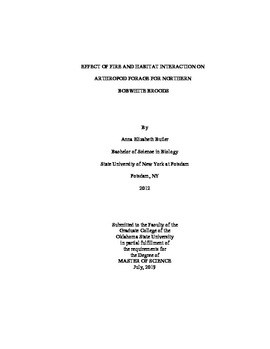| dc.description.abstract | Arthropods are abundant and diverse animals that dominate many terrestrial food webs and provide important ecosystem functions. Northern bobwhite (Galliformes, Colinus virginianus) chicks and reproducing hens require high quantities of arthropods in their diet during early chick development and female egg production. In western Oklahoma, shinnery oak shrubs (Quercus havardii) have hybridized with post oak (Quercus stellata) to create dense thickets of tall, woody vegetation, known as mottes. A gap exists in the current knowledge as to whether there are arthropods within mottes suitable for bobwhite forage. In one overall sampling design, I compared arthropod abundance and biomass along a gradient from mottes into open shrubland areas of different years since burn. Arthropods were collected in pitfall traps at four sampling locations in relation to mottes; in the center of mottes, and three plot location in open shrublands; 1m, 15m, and 50m away from the edge of the motte. There were three treatment levels for burning: one-year post burn (burned in dormant months of 2017), two-years post burn (burned in dormant months of 2016), and unburned (burned in dormant season of 2014 and prior). There was a difference in total arthropod abundance between the center of the motte and the open shrubland, with center plots having fewer total arthropods. For time since burn, the sum of all individuals across the entire study did not show significant differences however, when analyzed separately some individual arthropod orders showed differences between burn treatments. The findings of this study suggest that both fire and mottes can independently facilitate heterogeneity in arthropod communities, but they do not appear to interact with one another. The results of this study support the importance of maintaining heterogeneous landscapes to increase arthropod prey diversity, abundance, and biomass. We now know that mottes are a multifunctional aspect within bobwhites' range and that they provide food resources as well as protection. Prescribed fire does not seem to negatively affect the arthropod prey for bobwhites, nor does it detrimentally affect the arthropods inside mottes. | |
